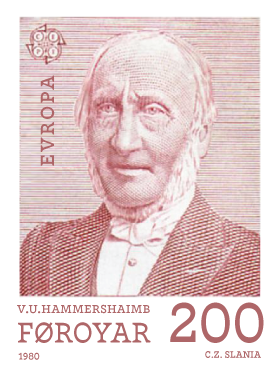

Sandavágur · September 1st, 2016
How to Tame a
Feral Language
Arrival on the Faroese Islands, for the very first time. As a Norwegian, I can read almost everything written on information signs and in newspaper headlines. But I hardly understand a single word of what is being said around me.
During the 15th century, the West-Nordic languages Icelandic, Norwegian and Faroese were forcefully replaced by the Danish overlords’ language as written languages. At that time what had once been Old West Norse, the common tongue wherever Norsemen had ventured, had become distinctly different languages. Icelandic remained conservative in grammar and morphology, while Norwegian rapidly lost most of its grammatical complexity. In-between were Faroese. And without written norms or any governing body for these languages, their differences grew greater and greater as the centuries came and went.
Eg eri i Føroyum í feriu í heyst Faroese
Eg er på Færøyane på ferie i haust Norwegian
Jeg er på Færøerne på ferie i efteråret Danish
Jag är på Färöarna på semester i höst Swedish
“I am on the Faroese Islands on vacation this autumn.” Comparison of the Nordic languages, from west to east. The three West-Nordic languages retain the inherited Old Norse lexicon, while Swedish have a loanword replacing the native word for “vacation”, and Danish has made a new word (“after-year”) replacing autumn. Faroese has a grammatical innovation not shared by the other languages, namely the form “eri” (1. person singular, “am”).
When time came to start writing Faroese, Icelandic and Norwegian again, their spoken forms had long since lost their mutual intelligibility and were in different ways heavily mixed with Danish. Iceland chose to purify their language by replacing foreign words with old stock. Norway went the opposite way by keeping the Danish, but putting Norwegian words and sounds back in. But Faroese was a different matter altogether. The small, isolated language had become much weirder than its bigger siblings. Parts of the old grammar were greatly reworked. Almost all sounds had changed, diphthongs had become monophthongs and vice versa, consonants had changed or disappeared, new ones had appeared seemingly out of nowhere. For instance , the Old Norse word for “island” was “ey”, pronounced exactly like it still is in Modern Norwegian (although we spell it “øy”). Icelandic kept the spelling, but now pronounced it like English “ay”. Meanwhile, in Faroese, time had turned the word to a short and vigorous “otch”. How on Earth should that be written?
Early proposals for written modern Faroese attempted to put its weirdness in writing more or less as it sounded. This presented a usual problem in language revivals: which dialect should serve as model for the orthography? Also, no one outside of the Faroese Islands would understand any of it, no matter how closely related the language once was.
Óó Øø Úú Ýý
The unfamiliar letters of the Faroese alphabet.
Enter Venceslaus Ulricus Hammershaimb (1819–1909) from Sandavágur on Vágar. This oddly-named fellow (even by Faroese standards) knew what to do. A teacher and a Lutheran minister, he single-handedly created the modern Faroese language, and his method was etymology. Using Old Norse as a model, he created a written language that appears a lot more conservative than spoken Faroese really is (but not more so than the difference between spoken and written English). For instance, he retained the Old Norse letter ð (eth). This sound had disappeared from Faroese in the 15th century, but retaining it in writing made the etymology of many words a lot clearer.
This approach not only bypassed the dialect-problem, but also made the language easily understood by speakers of Icelandic, and to a great extent to many Norwegians. As an added bonus, Old Norse (and to some degree Icelandic) literature became accessible to the Faroese.
So how did “otch” end up being written? “Oyggj” is the answer. Although the diphthong was long gone in the singular nominative, it was retained in a mutated form in the names of the various islands (Eysturoy, Sandoy, Borðoy etc.). The “tch”-part was recognised by Mr. Hammershaimb as a regular phenomenon in similar words, who named it “skerping” (sharpening). This way he created a written language that retained some degree of “backwards compatibility” while still reflecting the changes that had occurred through the centuries.
Today, Faroese is a healthy, thriving language, spoken and written natively by some 66,000 people. Thanks to Venceslaus Ulricus Hammershaimb from Vágar.
The illustration show a Faroese postage stamp honouring Venceslaus Ulricus Hammershaimb, remixed with Nordvest. Follow #nordvesttour for the next instalment.